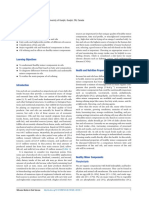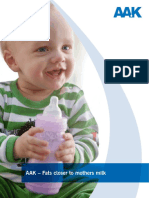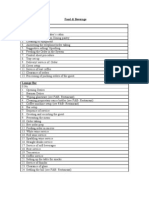ADA10 SunflowerAlmondButter
ADA10 SunflowerAlmondButter
Uploaded by
Li SchliemannCopyright:
Available Formats
ADA10 SunflowerAlmondButter
ADA10 SunflowerAlmondButter
Uploaded by
Li SchliemannOriginal Title
Copyright
Available Formats
Share this document
Did you find this document useful?
Is this content inappropriate?
Copyright:
Available Formats
ADA10 SunflowerAlmondButter
ADA10 SunflowerAlmondButter
Uploaded by
Li SchliemannCopyright:
Available Formats
Sunflower Seed Butter and Almond Butter as Nutrient-Rich
Alternatives to Peanut Butter
R. Thomas and S. Gebhardt; Beltsville Human Nutrition Research Center, ARS/USDA, Beltsville, MD
ABSTRACT Figure 1. Comparison of fatty acid composition of nut and seed
Over 3 million Americans are allergic to peanuts and/or tree nuts. Almond RESULTS butters
butter is an alternative to peanut butter for those who can tolerate tree nuts. Proximates (Table 1)
Those allergic to both may be able to consume sunflower seed butter. The • Protein – sunflower seed butter has significantly less (p<0.05) than almond and peanut butters. All three are
USDA Nutrient Data Laboratory is updating the nutrient profile for sunflower good sources (FDA 2008), but limited in lysine, methionine, and/or cystine amino acids.
Peanut 10.5 24.2 14.2
seed butter in light of the product’s reformulation using mid-oleic seeds and • Carbohydrate:
it addition
its dditi tto ththe S
School
h lL Lunch
hP Program, and d a new almond
l d bbutter
tt profile
fil • Total
T l dietary
di fiber
fib – 2 tbsp
b almond,
l d sunflower
fl seed,
d andd peanut butter
b provide
id 3.3
3 3 g, 1.8
1 8 g, andd 1.8
1 8 g,
will update the 1984 data currently in the USDA National Nutrient Database respectively.
(SR). Retail and/or manufacturer’s samples of sunflower seed butter and • Total sugars – almond butter did not have any sugar added whereas the other two butters did include
almond butter were sent to qualified laboratories for analysis of proximate nutritive sweetener.
components, minerals, vitamins, fatty acids, amino acids, and phytosterols. • Total fat – all three nut/seed butters provide about ¼ daily value of total fat per 2 tbsp. Sunflower 4.7 39 9.8
Results for the sunflower seed and almond butters were compared to existing Fatty Acids (Figure 1)
nutrient data for peanut butter in SR using Student’s t-tests (significance at • Sunflower seed butter has been reformulated using mid-oleic sunflower seeds. Consequently, our results
p<.05). Sunflower seed butter had significantly more monounsaturated fat, showed sunflower seed butter had significantly more monounsaturated fat (MUFA) than peanut or almond
magnesium, phosphorus, zinc, copper, and selenium than either almond or butters (p<0.05).
peanut butter. Almond butter had significantly more fiber, calcium, and Almond 4.4 33.9 14.2
• Almond and sunflower seed butters had significantly less (about half) saturated fat than peanut butter.
potassium than sunflower seed or peanut butter. Sunflower seed and almond
butter had significantly more iron, manganese, and vitamin E, and less Minerals and Vitamins (Table 1 and Figure 2)
saturated fat than peanut butter. Based on these recent analyses, two • Almond butter had significantly more calcium and potassium than sunflower seed or peanut butter (p < 0 10 20 30 40 50 60
tablespoons of almond, sunflower seed, and peanut butters each provide 0.05). g/100 g
>10% DV for protein, magnesium, phosphorus, manganese, and vitamin E. • Sunflower seed butter had significantly more magnesium, phosphorus, zinc, copper, and selenium than either Sat. Fat MUFA PUFA
These data provide updated nutrient profiles for almond butter and sunflower almond or ppeanut butter.
seed butter which are especially useful for individuals allergic to peanuts. • Almond and sunflower seed butter had significantly more iron and manganese than peanut butter. Figure 2. Comparison of select minerals in nut and seed butters
• Almond butter is an excellent source of magnesium and manganese and good source of calcium, phosphorus,
800
INTRODUCTION and copper.
Sunflower seed and almond butters are important as potential alternatives to • Sunflower seed butter is an excellent source of magnesium, phosphorus, copper, manganese, and selenium a
peanut butter for those sensitive to peanuts. and a good source of zinc. 700
• Sodium – almond butter had no salt added, whereas the other two butters did. Almond and sunflower seed b
Sunflower Seed Butter
butters are considered low sodium, whereas peanut butter has more than 140 mg/serving so does not qualify 600
e o u ated us
Reformulated usingg mid-oleic
d o e c fatty
atty ac d su
acid owe seeds (o
sunflower (oil iss 65% for that label claim.
claim b
b
C18:1) and optimal quantities of sugar, salt, and stabilizer, based on • Almond butter is a good source of riboflavin, sunflower seed butter is a good source of niacin and both are 500
texture, flavor, color, and oil separation (Lima 2005). excellent sources of vitamin E. a
Added to School Lunch Program. 400
mg/100 g
Almond Butter Table 1. Results per 2 tbsp (32 g) serving of almond, sunflower seed and peanut a* c
Updated with recent analyses. butters compared to recommended Daily Value (DV) 300
b
a
Almond Butter Sunflower Seed Butter Peanut Butter 200
2 tbsp %DV 2 tbsp %DV 2 tbsp %DV c
Energy, kcal 196 197 2
188 100
Protein, g 6.7 13 5.5 11 7.0 14
b b
Total lipid (fat), g 17.8 27 17.7 27 15.9 24
0
Total carbohydrate, g 6.0 * 7.5 * 7.7 * Calcium Magnesium Phosphorus Potassium
Total dietary fiber, g 3.3 13 1.8 7 1.8 7
SAMPLING AND ANALYTICAL METHODS Total sugars, g 1.4 3.4 2.1 Almond Sunflower Peanut
Almond butter Calcium mg
Calcium, 111 11 20 * 17 * *For each nutrient,
nutrient different letters indicate means are significantly different (P<0.05).
(P<0 05)
Almond Board of California had 8 different retail samples of Iron, mg 1.12 6 1.32 7 0.69 *
unsalted almond butter analyzed at a commercial lab and submitted Magnesium, mg 89 22 100 25 57 14 CONCLUSIONS
results to NDL for thorough review. Market checks indicate unsalted is Phosphorus, mg 163 16 213 21 107 11 Most sunflower seed butter on the market, as well as the commodity product used in
more predominant than salted almond butter. Potassium, mg 239 7 184 5 189 5 the School Lunch Program, has been reformulated using mid-oleic sunflower seeds,
Sunflower butter Sodium, mg 2 106 152 making it significantly higher in monounsaturated fat (MUFA) than peanut or
Samples obtained from manufacturer and local retail outlet; total of 3 Zinc, mg 1.05 7 1.56 10 0.85 6 almond butters.
p
composites. Copper, mg 0.30 15 0.51 25 0.18 9 p
Compared p
to peanut butter,, almond butter and sunflower seed butter are also good
g or
Food Analysis Laboratory Control Center at Virginia Polytechnic Manganese, mg 0.68 34 0.66 33 0.44 22 excellent sources of protein, magnesium, phosphorus, manganese, and vitamin E, yet
Institute and State University prepared samples according to their Selenium, µg 0.7 * 33.3 48 12.9 18 all three are also high in fat. Sunflower seed butter has the highest amount of many
standard protocols and shipped composited samples to pre-qualified Thiamin, mg 0.01 * 0.02 * 0.04 * minerals, whereas almond butter is the only good source of fiber and calcium.
analytical laboratories along with quality control materials. Riboflavin, mg 0.30 18 0.05 * NA
Niacin, mg 1.01 5 2.16 11 4.21 21 With recent Release 23 of the USDA National Nutrient Database for Standard
Laboratories conducted analyses of proximate components, sugars, Reference, consumers and health professionals have current nutrient composition of
dietary fiber, vitamins, minerals, fatty acids, amino acids, and Vitamin B6, mg 0.10 5 0.18 9 0.18 9
almond butter and sunflower seed butter which is especially useful to those allergic
phytosterols using AOAC or other published methods. Pantothenic acid, mg 0.03 * 0.37 * 0.33 * to or counseling clients allergic to peanut butter.
Vitamin E (α-tocopherol),
(α tocopherol) mg 7 75
7.75 39 7 32
7.32 37 1 90
1.90 10
Peanut butter data used for comparison were from previous study; samples Total plant sterols, mg 45 67 NA
obtained from USDA commodity vendors; total of 5 composites. REFERENCES
* < 5% DV Lima, I.M. and Guraya, H.S. 2005. Optimization analysis of sunflower butter. J
Statistical analysis Yellow highlights indicate good source (10-19% DV) and green highlights indicate excellent source (>20% DV) Food Sci. 70:S365-S370.
Used Student’s t-test to determine significance of differences among (FDA 2008) U.S. Food and Drug Administration (FDA). 2008. Guidance for industry: A food
nutrient values for almond, sunflower seed and peanut butters. NA = Not Analyzed labeling guide. Accessed 10/19/2010 at www.fda.gov.
You might also like
- Waist Trimmer Guide by Artemus Dolgin PDFDocument14 pagesWaist Trimmer Guide by Artemus Dolgin PDFalok chawla100% (9)
- Healthy Fats and Oils: Topic HighlightsDocument11 pagesHealthy Fats and Oils: Topic HighlightsAditia Habibul AkbarNo ratings yet
- Nuts Oil Seeds and Sugar UnitDocument16 pagesNuts Oil Seeds and Sugar UnitIyappan SubramaniNo ratings yet
- Fedna: Grains in Nutrition For Farm AnimalsDocument10 pagesFedna: Grains in Nutrition For Farm AnimalsMohammed AdilNo ratings yet
- Tancharoenrat 2013Document7 pagesTancharoenrat 2013Yeonjun ChoiNo ratings yet
- Mapeh ExamDocument14 pagesMapeh Examjmdaliva80No ratings yet
- Hemp NutritionDocument2 pagesHemp NutritionZipi Mosseri100% (1)
- Wheat FlourDocument8 pagesWheat FlourIrham Hikmawan RamadhanNo ratings yet
- Video Lesson For Animal Production 11Document23 pagesVideo Lesson For Animal Production 11michael hobayanNo ratings yet
- Characteristics and Composition of Watermelon, Pumpkin, and Paprika Seed Oils and FloursDocument7 pagesCharacteristics and Composition of Watermelon, Pumpkin, and Paprika Seed Oils and FloursAzzahraAuralitaSafitriNo ratings yet
- Cereal Chem - 2018 - Badea - Tocols and Oil Content in Whole Grain Brewer S Spent Grain and Pearling Fractions of MaltingDocument11 pagesCereal Chem - 2018 - Badea - Tocols and Oil Content in Whole Grain Brewer S Spent Grain and Pearling Fractions of MaltingNhật Nguyễn SĩNo ratings yet
- Topic 6Document13 pagesTopic 6Faith GregorioNo ratings yet
- 10 1016@j LWT 2019 03 092Document9 pages10 1016@j LWT 2019 03 092Jaqueline Silva jaqueNo ratings yet
- Biochemical Properties of Whole and Degermed Maize Flours During StorageDocument6 pagesBiochemical Properties of Whole and Degermed Maize Flours During StorageBiochem M. JulyNo ratings yet
- Diploma ProjectDocument53 pagesDiploma Projectvarshikonline servicesNo ratings yet
- Imrsf SoboDocument93 pagesImrsf SoboJessica ThomasNo ratings yet
- C009 (1) - Corrected ProofDocument18 pagesC009 (1) - Corrected Proofhod.foodtechNo ratings yet
- Mango Seed Kernel, A Highly Nutritious Food, Should We Continue To Trash or Use?Document4 pagesMango Seed Kernel, A Highly Nutritious Food, Should We Continue To Trash or Use?Mr. technicianNo ratings yet
- ConcentrateDocument16 pagesConcentrateAnonymous o477B0N2VmNo ratings yet
- Date Phoenix Dactylifera L by Products 2Document8 pagesDate Phoenix Dactylifera L by Products 2Karim HosniNo ratings yet
- Characteristics of Hemp (Cannabis Sativa L.) Seed OilDocument11 pagesCharacteristics of Hemp (Cannabis Sativa L.) Seed OildimbeswardasNo ratings yet
- MILLETSDocument12 pagesMILLETSsuparnaranaNo ratings yet
- UEU Ilmu Bahan Makanan Pertemuan 3Document130 pagesUEU Ilmu Bahan Makanan Pertemuan 3Yola SiregarNo ratings yet
- Serealia Dan Kacang-KacanganDocument130 pagesSerealia Dan Kacang-KacanganAnissa YulianaNo ratings yet
- Aakansha PresentationDocument37 pagesAakansha PresentationVeer SinghNo ratings yet
- 2023 Triglycerides of Medium Chain Fatty Acids: A Concise ReviewDocument10 pages2023 Triglycerides of Medium Chain Fatty Acids: A Concise Reviewsyahminar_rahmaniNo ratings yet
- Research Article: Sahar Shibli, Farzana Siddique, Saeeda Raza, Zaheer Ahsan and Irum RazaDocument11 pagesResearch Article: Sahar Shibli, Farzana Siddique, Saeeda Raza, Zaheer Ahsan and Irum RazaAyeshaNo ratings yet
- Classification Feed and FodderDocument4 pagesClassification Feed and FoddermathiNo ratings yet
- Pharmaceutical Profile of Alpha-Tocopherol - A Brief ReviewDocument17 pagesPharmaceutical Profile of Alpha-Tocopherol - A Brief ReviewBeatriz PatricioNo ratings yet
- Chapter 3LIPIDSDocument26 pagesChapter 3LIPIDSDilny Casey PatanaNo ratings yet
- Tamarind: Value Added Products and Its Health Benefits: Krishi Vigyan Kendra, Kaneri, Kolhapur, MaharashtraDocument5 pagesTamarind: Value Added Products and Its Health Benefits: Krishi Vigyan Kendra, Kaneri, Kolhapur, MaharashtraSitar JoshiNo ratings yet
- Vanbergue Et Al., 2018Document8 pagesVanbergue Et Al., 2018Luis Alberto Canul KuNo ratings yet
- Millets Pasta HandbookDocument30 pagesMillets Pasta Handbookmubashirasyed24No ratings yet
- Hemp Seeds and Hemp Oil As Food EIHA EIHADocument6 pagesHemp Seeds and Hemp Oil As Food EIHA EIHAZipi MosseriNo ratings yet
- Anti-Oxidant Vitamins, Minerals and Tannins in Oil From Groundnuts and Oyster Nuts Grown in UgandaDocument7 pagesAnti-Oxidant Vitamins, Minerals and Tannins in Oil From Groundnuts and Oyster Nuts Grown in UgandaScivision PublishersNo ratings yet
- 2012 Article 677 PDFDocument15 pages2012 Article 677 PDFTommy RamazzottoNo ratings yet
- AAK Fats Closer To Mothers Milk 2Document6 pagesAAK Fats Closer To Mothers Milk 2Jing DalaganNo ratings yet
- GNLD's Tre en en Grain Concentrates - Fast FactsDocument4 pagesGNLD's Tre en en Grain Concentrates - Fast FactsNishit KotakNo ratings yet
- Sabar TMR Project For NLM - 03 Oct 2023Document12 pagesSabar TMR Project For NLM - 03 Oct 2023Divyant PatelNo ratings yet
- Jackfruit (Artocarpus Heterophyllus) Seed Oil As An Alternative For Cooking OilDocument18 pagesJackfruit (Artocarpus Heterophyllus) Seed Oil As An Alternative For Cooking OilKeizer FiscoNo ratings yet
- Ins 4 Insect Oil and Protein Biochemistry, Food and Other Uses - ReviewDocument5 pagesIns 4 Insect Oil and Protein Biochemistry, Food and Other Uses - ReviewMohamedNo ratings yet
- Final Feed AdvisoryDocument6 pagesFinal Feed AdvisoryPraveen KumarNo ratings yet
- Nutrients: Can Early Omega-3 Fatty Acid Exposure Reduce Risk of Childhood Allergic Disease?Document16 pagesNutrients: Can Early Omega-3 Fatty Acid Exposure Reduce Risk of Childhood Allergic Disease?Alif RahmanNo ratings yet
- Seabank Statement 20240504Document28 pagesSeabank Statement 20240504Sheryl Bastillada PasteraNo ratings yet
- Sustainable Sesame (Sesamum Indicum L.) Production Through Improved Technology: An Overview of Production, Challenges, and Opportunities in MyanmarDocument21 pagesSustainable Sesame (Sesamum Indicum L.) Production Through Improved Technology: An Overview of Production, Challenges, and Opportunities in MyanmarDiptiranjan PandaNo ratings yet
- 2013EC Source-Extraction-And-Constituents-Of-Fats-And-OilsDocument8 pages2013EC Source-Extraction-And-Constituents-Of-Fats-And-OilsĜĭdęŷ KîřöşNo ratings yet
- Feed Processing Technology: January 2003Document11 pagesFeed Processing Technology: January 2003yasir majeedNo ratings yet
- Date Palm Seeds نوى البلحDocument5 pagesDate Palm Seeds نوى البلحhhes8116No ratings yet
- RB in Poultry Feed - 4Document32 pagesRB in Poultry Feed - 4Vishwanath HebbiNo ratings yet
- CXG 8-1991 Guidelines On Formulated Complementary Foods For Older Infants and Young ChildrenDocument10 pagesCXG 8-1991 Guidelines On Formulated Complementary Foods For Older Infants and Young Childrenlinh huynhNo ratings yet
- EJFS - Volume 48 - Issue 2 - Pages 389-396Document10 pagesEJFS - Volume 48 - Issue 2 - Pages 389-396adrajksaNo ratings yet
- National Kidney Foundation-Superfood-NutsseedsDocument2 pagesNational Kidney Foundation-Superfood-NutsseedskhurrummeerNo ratings yet
- Moringa Research Paper Posted by YoumanitasDocument1 pageMoringa Research Paper Posted by YoumanitasGinoNo ratings yet
- Banana and Plantain As Medicinal FoodDocument5 pagesBanana and Plantain As Medicinal Fooddevanti trisNo ratings yet
- Watermelon PropertiesDocument9 pagesWatermelon PropertiesLouhana Moreira ReboucasNo ratings yet
- JON6971721668889800Document12 pagesJON6971721668889800lvictimNo ratings yet
- Grade10 TLE Cookery Q1 W5Document15 pagesGrade10 TLE Cookery Q1 W5Trisha Faye DeriadaNo ratings yet
- 2019 U.S. Soybean Oil Benefits A Guide For Health Professionals 1Document20 pages2019 U.S. Soybean Oil Benefits A Guide For Health Professionals 1deaconbukat03No ratings yet
- Trait-Modified Oils in FoodsFrom EverandTrait-Modified Oils in FoodsFrank T. OrthoeferNo ratings yet
- Whole Grains and their Bioactives: Composition and HealthFrom EverandWhole Grains and their Bioactives: Composition and HealthJodee JohnsonNo ratings yet
- BestofBetty 2010-3Document26 pagesBestofBetty 2010-3dianedowning100% (3)
- Startup and Operating Costs of Small Farmstead Cheese Operations For Dairy SheepDocument14 pagesStartup and Operating Costs of Small Farmstead Cheese Operations For Dairy Sheeppmithesh879No ratings yet
- Health & Place: Renee E. Walker, Christopher R. Keane, Jessica G. BurkeDocument9 pagesHealth & Place: Renee E. Walker, Christopher R. Keane, Jessica G. BurkeBengt HörbergNo ratings yet
- Food Cart Menu & Tuck ShopDocument2 pagesFood Cart Menu & Tuck ShopAsha JamesNo ratings yet
- Chapter6 - Feeds and Feeding The FishDocument23 pagesChapter6 - Feeds and Feeding The Fishፋሲል ታደሰ100% (3)
- Eat To Live by Joel FuhrmanDocument10 pagesEat To Live by Joel FuhrmansimasNo ratings yet
- Types of DessertDocument17 pagesTypes of DessertMa OdetteNo ratings yet
- Term 2A 2022 - Biscuit BearDocument3 pagesTerm 2A 2022 - Biscuit BearWan ReceiptsNo ratings yet
- P.Edu. Ch-2 For Class 12thDocument22 pagesP.Edu. Ch-2 For Class 12thkapil sharma0% (1)
- Dessert Quiz and Package Prep Food QuizDocument3 pagesDessert Quiz and Package Prep Food QuizligayaNo ratings yet
- Food Sustainability Problems Perspectives and SolutionsDocument11 pagesFood Sustainability Problems Perspectives and SolutionsaaNo ratings yet
- RS. Medika BSD Periode:: List Stock Opname PeralatanDocument5 pagesRS. Medika BSD Periode:: List Stock Opname PeralatanihsanfnNo ratings yet
- FSM 3 Module 1 - 1 - A 2022-2023Document4 pagesFSM 3 Module 1 - 1 - A 2022-2023Borela MoniqueNo ratings yet
- Food ProductionDocument30 pagesFood ProductionGovind SharmaNo ratings yet
- Marital N IndustryDocument55 pagesMarital N Industrygg ggNo ratings yet
- Sourdough Starter Annotated BibliographyDocument2 pagesSourdough Starter Annotated Bibliographyapi-263195155No ratings yet
- James Malcolm Sattler: Food Services ManagerDocument2 pagesJames Malcolm Sattler: Food Services ManagersatrioNo ratings yet
- Moms Club December NewsletterDocument5 pagesMoms Club December Newsletterapi-157619843No ratings yet
- Business Plan Template 1 - 105642Document12 pagesBusiness Plan Template 1 - 105642Leinel Macutay MalazzabNo ratings yet
- 3 Ingredients OnlyDocument41 pages3 Ingredients OnlyAli Mohammadi100% (1)
- Milk SpoilageDocument3 pagesMilk SpoilageTiiny KiingNo ratings yet
- Jurnal KopiDocument10 pagesJurnal KopiSadatul UmamiNo ratings yet
- KFC Company: (Modern Manner)Document39 pagesKFC Company: (Modern Manner)Nguyễn Thế DươngNo ratings yet
- Populars Sandwich and MoreDocument30 pagesPopulars Sandwich and MoreMuthu SwamyNo ratings yet
- Dinner Party Wbs PMDocument24 pagesDinner Party Wbs PMjagadeeshNo ratings yet
- 6L Slow Cooker: Instructions & WarrantyDocument24 pages6L Slow Cooker: Instructions & WarrantyKarthik KurapatiNo ratings yet
- F&B Manual IndexDocument3 pagesF&B Manual Indexvinsgupta80% (5)
- Part 1 (5 Marks) Read and Circle The Correct Answer.: UASA BI Y3 (2022/2023)Document6 pagesPart 1 (5 Marks) Read and Circle The Correct Answer.: UASA BI Y3 (2022/2023)Pretty Elka K GeorgeNo ratings yet
- Write How Much or How ManyDocument5 pagesWrite How Much or How ManyMaria Del Carmen PalominoNo ratings yet

























































































